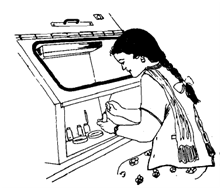Handling : You can reduce direct contact with microorganisms by careful handling and by wearing protective clothing such as rubber gloves, mask, lab coat, etc. Even if you entirely eliminate the likelihood of direct contact, you could still be at risk because of airborne organisms from the formation of aerosol droplets and dispersal of fungal spores. If these hazards do exist, work should be carried on in a sterile cabinet with a filtered exhaust, such as a transfer chamber i.e., a laminar flow show in the figure. In LT-2 course you will study about general structure and functioning of a leminar flow.

Figure: A transfer chamber
Non-pathogenic and approved cultures can be transferred in the open laboratory so long as you use correct aseptic techniques. It is important in this technique to ensure that the work bench is cleaned by spirit. It is always better if the work bench has water proof cover that can be removed and washed if spillage occurs. Spirit lamps should be used for heating the surrounding air as heating the air has germicidal effect. The wire or loop used for inoculation is sterilized and cooled before it touches the culture, otherwise sizzling occurs with aerosol droplets thrown into the air. You must take care that before lighting the flame the spirit used for wiping the working table should completely dry, as spirit is highly inflammable. (You should not wear gloves while working near a burner or a spirit lamp. When pipetting, you can avoid splashing by releasing the contents of the pipette under or onto the surface of the receiver - don't release it from a height. Keep a discard jar or tray with a disinfectant in it, on the work bench so that you can put used pipettes, loops, swabs etc. in it. You will be far safer if you regard all microorganisms as pathogenic because even harmless ones may be contaminated by dangerous forms.
There are other aspects of handling microorganisms which should receive your attention. For instance, you could easily become contaminated from culture plates, therefore you should seal petri dishes with clear tape before allowing them to be examined by you or inexperienced students. If you wish to kill the microorganisms in the petri dish before they are examined (and it is possible to use killed cells for microscopic examination), you can insert a filter paper soaked in 40% methanol into the inverted dish. To avoid poisonous methanol fumes, carry out this operation in fume cupboard, and leave the dish for twelve hours.
As with other biological techniques, you should always take care to sterilize the equipment after you've used it to cut down the chances of infection. You will also ensure that infection is contained if you have a bottle of disinfectant on hand to deal with any upsets. A 10% hypochlorite solution or mentholated spirit can be used.
A similar situation can be while working with plant materials. You can encounter pollens or other plant parts and products that can cause allergies, cuts and bruises. As in case of microorganisms you can reduce the risk by wearing gloves, masks and lab coat while working with such materials. If you are handling some known all ergins, it is advisable to work on a fume cupboard with filtered exhaust. If such cupboard is not available in your lab, work in open area with proper aeration and exhaust.